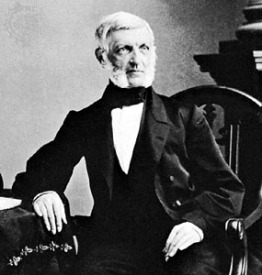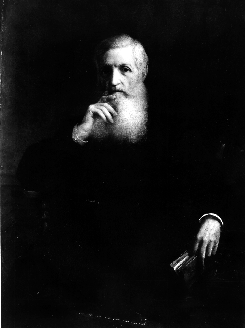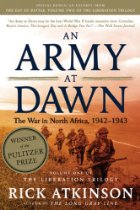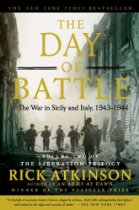Archive for the ‘Writing about History’ Category
Acquisition: An Army At Dawn: The War in North Africa, 1942 – 1943 Plus…
Just a note that I’ve picked up a copy of An Army at Dawn: The War in North Africa, 1942-1943 by Rick Atkinson. This book, the first in his Liberation Trilogy, won the Pulitzer Prize. I was quite impressed by Mr. Atkinson’s book, Crusade: The Untold Story of the Persian Gulf War, which I reviewed here.
Paperback: 768 pages
Publisher: Holt Paperbacks; Revised edition (May 15, 2007)
Language: English
ISBN-10: 0805087249
ISBN-13: 978-0805087246
I also purchased the second book in the trilogy, The Day of Battle: The War in Sicily and Italy, 1943-1944, which many reviewers have indicated surpasses the first.
Paperback: 848 pages
Publisher: Holt Paperbacks; Reprint edition (September 16, 2008)
Language: English
ISBN-10: 080508861X
ISBN-13: 978-0805088618
Even better, I’ve discovered that most of Mr. Atkinson’s books are available in audio format free from my local public library and so they will be on my MP3. Sweet!
Next Class: Antebellum America: Prelude to Civil War
After a short break, I’ll be diving into my next class which starts November 3rd. As is my custom, I’ve added this to “The Courses” page.
“Antebellum America: Prelude to Civil War” (starts November 3rd)
This course is an analysis of the conditions existing in the United States in the first half of the 19th century. The course focuses on the political, cultural/social, economic, security, leadership, and other issues that played roles in starting and shaping the Civil War. We will analyze the issues in the context of war and peace to determine whether or not such conflicts as civil wars can be avoided prior to their inception.
Required Texts:
TBD once the syllabus is available. For now, the list is as follows which is very light in comparison with my last class:
 Publisher: W. W. Norton and Company
Publisher: W. W. Norton and CompanyHalf Slave and Half Free : The Roots of Civil War by Bruce Levine
Road to Disunion : Secessionists at Bay, 1776-1854, Volume 1 by William W. Freehling
The Philippine War, 1899-1902
Brian McAllister Linn. The Philippine War, 1899-1902. Reprint. University Press of Kansas, 2000.
Brian Linn recounts the military operations that took place between the opening months of 1899 and July 1902 in what some of his reviewers have labeled as the “definite study” of the Philippine War. Ultimately, his goal is to set the record straight on the myths surrounding the conflict and recount its history as the complex and challenging event it was. Written from the American perspective, he concludes that the war was nothing less than the most successful counterinsurgency campaign in U.S. history.
He sets out to write a narrative history of the conflict but admits to encountering challenges because the war varied so greatly in the different locations in which it took place. The geographical expanse of the Philippines thus becomes a part of the story of the war itself. These challenges lead Linn to organize the book around two broad themes. The first section describes conventional military operations on the island of Luzon that took place in 1899. The second focuses on operations in other parts of the archipelago which can be categorized as guerrilla warfare and pacification activities.
While the book’s focus is on United States military activities, Linn provides excellent historical background on the Philippine leadership cadre as well. He makes specific mention of the need for a study that more comprehensively represents the Filipino perspective of the conflict. Linn is blatantly honest about the strengths and the foibles of both the United States military and the Philippine Army of Liberation. He captures the intra-service rivalries and associated squabbles and maneuvering for notice and promotion among officers on both sides. He also describes the performance of America’s volunteer citizen-soldiers, who distinguished themselves by behaving with aggressiveness, courage, and élan, and yet were at times difficult to restrain.
Linn captures well instances of the fog of war and its impact on both sides. He provides a fascinating description of the recruitment, training, transport, and sustaining of volunteer American troops engaged in the conflict. His review of the Battle of Manila reveals superior preparation and discipline among American troops and yet the recklessness of officers who ordered repeated frontal attacks over open ground against armed fortifications. He notes that most of these attacks were successful due primarily to insurgents shooting high. Linn points out that this gave the Filipinos the impression of American invincibility, increasing the fear, uncertainty, and doubt that at times caused native soldiers to flee.
Linn arrives at several important conclusions. First he refutes the clichés so often attributed to the Philippine War. He posits that while the U.S. military was victorious, this occurred as a result of the ineptitude of the independence movement and its “titular leader,” Aguinaldo, as opposed to the prowess of the Americans. Some guerrilla leaders showed brilliance at the small unit level but there was never a successful prolonged defense of any area or recovery of any areas once lost. Rebels also failed to effectively win the broad support of the populace. American forces struggled with a number of problems including maintenance of forces levels, diseases, and logistics.
Americans did have clear advantages in weaponry and this added to their effectiveness. The Krag rifle, armed gunboats, and field artillery were all contributory to American success. The U.S Navy was also a key contributor to the win providing not only transport of men and matériels but also blockade functions and support for amphibious operations. Linn also points to the role of civic action or social reform as a crucial component of the American victory.
Because of the unique nature of this conflict, and its counter insurgency flavor, Linn suggests that it has much to offer readers of both civilian and military cadres. I agree. The book’s notes section is impressive as is the bibliography. The book has received the following honors: Army Chief of Staff’s Professional Reading List, Air Force Chief of Staff’s Professional Reading List, Winner of the Society for Military History Distinguished Book Award, Selection of the History Book Club.
At the time of the book’s publication, Brian Linn was professor of history at Texas A & M University, a post he has held since 1998. He received a B.A. with High Honors from the University of Hawaii, and M.A. and Ph.D. from The Ohio State University. He has also taught history at Old Dominion University and the University of Nebraska as a visiting professor. He is widely published and the recipient of numerous grants and fellowships.
Overall, Linn’s work is an important contribution to U.S. military scholarship.
New Addition – Sweetsmoke by David Fuller
I received a review copy of David Fuller’s Sweetsmoke today from the good folks at Hyperion and very much look forward to reading it and passing along my impressions. Mr. Fuller is a screenwriter by profession. He has an interesting lineage of combatants in the American Civil War, which you can read more about on his website here.

A Revolutionary People at War: The Continental Army and American Character, 1775-1783
Charles Royster. A Revolutionary People at War: The Continental Army and American Character, 1775-1783. Reprint. University of North Carolina Press, 1996.
In his award winning, sweeping work on the American Revolution, Charles Royster sets out to prove his thesis that “there was an American character prevalent during the War for Independence and that we can profitably analyze it.” His focus is on the emotions, attitudes, and conduct of Americans in wartime but he also set out to prove that Americans exemplified collectively the disposition of revolutionaries. This notion of national character is an important one because it suggests an emergence of a sense of nationhood among the inhabitants of America’s colonies. Royster acknowledges that not all Americans were anti-British but he does conclude that the majority of Americans during the War for Independence were loyal to the revolution’s cause. These arguments are foundational to his discussion of the Continental Army. Royster deals with the rather broad topics of the ideals of revolutionary citizenship, society, and state by limiting his scope to the standards “that Americans defined for themselves in creating, recruiting, and fighting in an army” and it is this focus that makes the book more relevant to the military historian. He finds evidence of a disparity between society’s ideals and its actual conduct, the latter being “always flawed.” To find reasons for the disparity he touches, admitted lightly, on other areas such as religion, government, and commerce, drawing a connection between these and the way in which Americans related to the army.
Royster describes his book as analytical rather than narrative history. This distinction drives the book’s chronological format which supports his position that the study of revolutionary attitudes and the changes that took place over time are best observed “in the order that Americans experienced them.” Royster begins with an examination of the high ideals that Americans caught up in the revolutionary mindset placed upon themselves and others, ideals of virtue and valor. This foundation then allows him to explore the “tension” created when Americans failed to live up to those ideals and how they dealt with the disparity between desired standards and reality. Thus Royster begins with the years prior to the war’s start, describes the “rage militaire” of 1775, and then proceeds through the early war years in a series of chapters with religious titles and analogous themes: 1776: The Army of Israel, Jericho, and The Promised Land. The second half of the book focuses on Valley Forge, Treason, Division, and finally Legacy. It is in this final chapter that Royster brings together his analysis of the whole of the American experience at war.
This work is intended for students of early American history and particularly those who want to better understand the American Revolution. It should also find interest among military historians because of its focus on the experience of soldiers in the American Army of Independence as well as the institutional history of America’s armed forces. Royster’s forays into the realms of sociology, psychology, political, and civic history, should allow the book to find even broader readership. The work’s extensive notes section is worth mention. There is also an essay in the appendix that challenges some other authors who draw conclusions too quickly from statistics about American soldiers who fought in the Revolution, many of whom were both young and poor. The book is particularly noteworthy for its use of readily available primary sources but fresh approach to the information contained therein. His presentation is entirely satisfying albeit occasionally repetitive. One of the clear strengths of the book is its introduction to the reader of a broad number of characters of the period often through their own narrative or those of others around them.
Charles Royster brings impressive credentials to his work which is a shortened version of his doctoral dissertation. He received all of his degrees from the University of California, Berkeley including an A.B. (1966), M.A. (1967), and Ph.D. (1977). At the time of the book’s publication, Dr. Royster was assistant professor of history at the University of Texas. He is now professor of history at the Louisiana State University. Royster has amassed an impressive list of publications several of which received academically recognized awards. His work Stonewall Jackson, and the Americans won the Bancroft Prize, The Lincoln Prize, and the Charles S. Sydnor Award in Southern History. A Revolutionary People at War was recognized with the 1981 Francis Parkman Prize from the Society of American Historians, the 1979 John D. Rockefeller III Award, the 1981 National Historical Society Book Prize, the 1980 Fraunces Tavern Museum Book Award from the Sons of the Revolution in the State of New York, and the 1980 Silver Medal, Nonfiction from the Commonwealth Club of California.
Overall, Royster provides an excellent addition to scholarship of early America.
Scientific Optimism: Jomini and the U.S. Army
Those of you who follow my postings know that I’ve ruminated a bit on Jomini (pictured above). You can find the complete list of related posts here. For those who find discussion of Jomini and Clausewitz interesting, I wanted to pass along a link to an excellent essay by Major Gregory Ebner titled “Scientific Optimism: Jomini and the U.S. Army” available here. Ebner, in an essay that appears as a featured article in The U.S. Army Professional Writing Collection, makes a case for how the U. S. Army presents itself as a Clausewitzian organization at upper levels but is “firmly rooted in the ideals of Antoine-Henry Jomini” at the tactical and operational levels. He posits that focus on “good staff work and the military decision-making process (MDMP)” reflects a reliance on military science and method over the application of genius as espoused by Clausewitz. He further suggests that the Principles of War developed by the U.S. Amy was an encoding of Jomini in the form of doctrine. This essay is instructive to the study of military philosophers and military thought on several fronts. First, for the military philosophy student, it reinforces the theories of both Clausewitz and Jomini and would therefore make an excellent reading assignment after studying the primary works of both theorists. Second, it provides insight into the extent to which the largest army in present day has adopted and incorporated the ideas of both men at the doctrinal and operational levels.
For more information:
MDMP – Military Decision Making Process
Access “The Clausewitz Homepage” here.
May Civil War and Military History Book Acquisitions – II
Continuing with my May book acquisitions which illustrate, as said by Civil War Interactive’s comments on my blog this week, why bank robbery may be needed to support my book-buying habits…
This looks like a great read. Author Tom Wheeler, an accomplished man by any measure, has a terrific website here with more about his book and research. This has moved to the top of my list of reading for between terms.
I have DISCOVERED Dr. Hess and the growing list of terrific titles he has published on the Civil War. No doubt his other books will show up in my library before long. Dr. Hess, who has impressive academic credentials, has a website here. His book, Pickett’s Charge: The Last Attack at Gettysburg, was nominated for a Pulitzer Prize.
I’ve been intending to pick this up. Authored by military history professor and fellow blogger Mark Grimsley, it too is at the top of my reading list. Dr. Grimsley’s OSU webpage is here. His blog is here.
My post, “Fabian Strategy and the American Civil War” here, lead me to this book. One of my readers recommended it and suggests that it proves that the Confederacy could not have used the Fabian strategy effectively. I’m looking forward to this one.
Jav Luvaas is another prolific writer of military history and my collection of his books is growing. I first discovered his work while taking the course, Great Military Philosopers (see “The Courses” page here for details. I picked up his titles: Napoleon on the Art of War and Frederick the Great on the Art of War.
I’ll be adding these authors to my “The Historians” page shortly.
American Historian: George Bancroft
I’m back from Christmas break and trying to recuperate from a few too many cinnamon rolls. Reading assignments and preparation of a research proposal due Sunday are top of mind.
The class is Historiography so the research isn’t to be about the development and proof of a thesis. It’s more about research into the history of how history was written.
 For my research paper, I plan to explore the influence of historian George Bancroft (right) on Antebellum, Civil War, and Postbellum American history. I may need to shave this down a bit depending on how much material I find.
For my research paper, I plan to explore the influence of historian George Bancroft (right) on Antebellum, Civil War, and Postbellum American history. I may need to shave this down a bit depending on how much material I find.
Bancroft was one of the best known American historians of the 19thcentury. While Harvard educated (he entered at 13 and graduated at 17!), he is considered a “literary historian,” who wrote in a style popular with  the public. His primary work was the multi-volume History of the United States from the Discovery of the American Continent, which he began writing in 1830. [Picture left of remaining vHe published the first three volumes over that decade. The final set would be ten volumes. A first revision was completed and published as six volumes in 1876 as part of the national centennial.
the public. His primary work was the multi-volume History of the United States from the Discovery of the American Continent, which he began writing in 1830. [Picture left of remaining vHe published the first three volumes over that decade. The final set would be ten volumes. A first revision was completed and published as six volumes in 1876 as part of the national centennial.
Perhaps less known is that Bancroft, while Secretary of the Navy, created the Naval Academy. He was also chosen by Congress to eulogize Abraham Lincoln. The New York Times reprinted that Eulogy on the occasion of the fiftieth anniversary of the event in 1915. It, along with drawings of the event, can be seen in their entirety here.
I have located the index to his papers housed on microfiche at Cornell University and two biographies which leverage that material. The first, a two volume set 1971 reprint of M.A. DeWolfe Howe’s 1908 work The Life and Letters of George Bancroft, I was able to find on the Amazon Marketplace in almost pristine shape. The second, George Bancroft: Brahmin Rebel, was written by Russel B. Nye and published in 1945. It’s on order. There are other large collections of Bancroft materials in holdings by the Massachusetts Historical Society, the Library of Congress and the New York Public Library. I’m beginning in earnest a search for articles that deal with his contributions to American history as well.
As a follow-up at some later point, I think it would be very interesting to contrast the style and impact  of George Bancroft with Charles and Mary Beard. As a historian friend of mine said, “you’d be hard pressed to find two more different expositors on the American experience than Bancroft and Beard. Bancroft was an unabashed patriot and advocate of democracy, to a degree that would be considered embarrassing in most academic settings today. Still, he was indeed the most articulate and widely-read of our early historians, and his writings both reflected and helped to create the sense of American exceptionalism that has prevailed for most of our history as a nation.”
of George Bancroft with Charles and Mary Beard. As a historian friend of mine said, “you’d be hard pressed to find two more different expositors on the American experience than Bancroft and Beard. Bancroft was an unabashed patriot and advocate of democracy, to a degree that would be considered embarrassing in most academic settings today. Still, he was indeed the most articulate and widely-read of our early historians, and his writings both reflected and helped to create the sense of American exceptionalism that has prevailed for most of our history as a nation.”
You might recall that Charles and Mary Beard were the first to suggest that the Civil War was the second American revolution as was mentioned in my previous post here.
The exceptional oil on canvas portrait above of Bancroft in later life was painted by Gustav Richter, a German painter (1823 – 1884). It is a part of the Harvard University Portrait Collection and is on display at Memorial Hall.
More as I get into my research.
Photo credits:
Photo of George Bancroft in middle age taken by Mathew Brady, courtesy of the Library of Congress.
Photo of painting above: The President and Fellows of Harvard College.
New Class Started Today – Historiography
The next term started today! The class is “Historiography.” I’ve been looking forward to this class in that it steps back an d takes a look at the study of historical thought itself. I also consider it important for the development of solid historical research skills. From the course description, “it concentrates on how history has been interpreted, rather the facts of history themselves. The course contemplates the fundamental questions about the nature of history and investigates the relationships between theory and evidence in historical writing.”
d takes a look at the study of historical thought itself. I also consider it important for the development of solid historical research skills. From the course description, “it concentrates on how history has been interpreted, rather the facts of history themselves. The course contemplates the fundamental questions about the nature of history and investigates the relationships between theory and evidence in historical writing.”
The assignments will actually offer opportunity for some focus on the Civil War but I’m very interested in the more general topic.
I posted the reading list on “the courses” page in case you are interested including the web-based readings. Primary texts include the following:
Bentley, Michael. Modern Historiography: An Introduction. London: Routledge, 1999.
Breisach, Ernst. Historiography: Ancient, Medieval, and Modern, 2nd Edition. Chicago: University of Chicago Pre ss, 1994.
ss, 1994.
Green, Anna, and Kathleen Troup, eds. The Houses of History: A Critical Reader in Twentieth-Century History and Theory. New York: New York University Press, 1999.
Marius, Richard. A Short Guide to Writing about History. NY: Longmans, 1999
Turabian, Kate L. Manual for Writers of Term Papers, 6th Edition. Chicago: University of Chicago Press, 1996.











!["The Fight Between the Alabama and the Kearsarge" [NH59354]](https://wigwags.files.wordpress.com/2008/09/the-fight-between-the-alabama-and-the-kearsarge-nh59354.jpg?w=444&h=351)
































































